dashboard CITROEN C3 2022 Owners Manual
[x] Cancel search | Manufacturer: CITROEN, Model Year: 2022, Model line: C3, Model: CITROEN C3 2022Pages: 450, PDF Size: 10.11 MB
Page 9 of 450
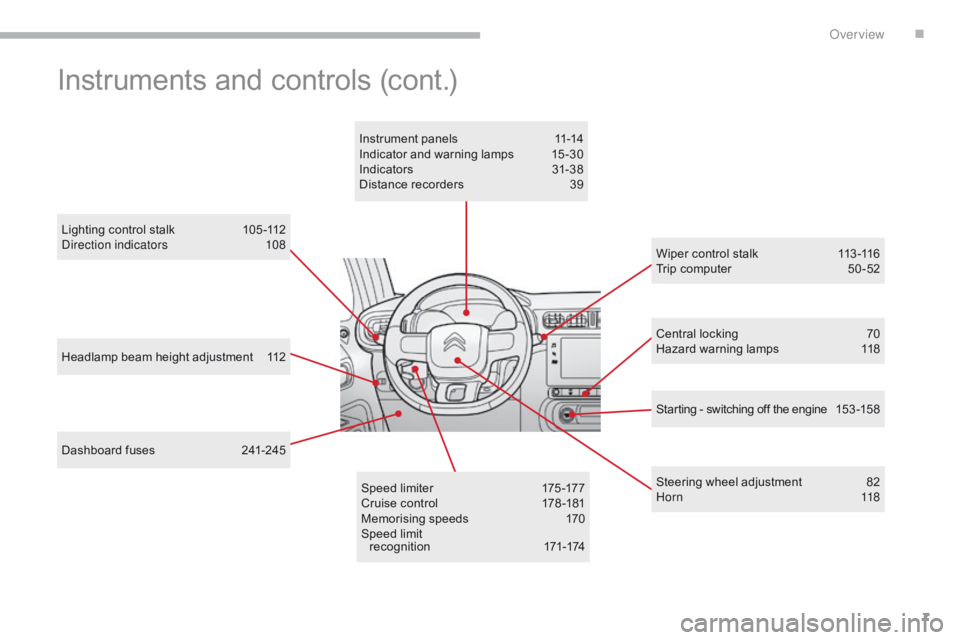
7
B618_en_Chap00b_vue-ensemble_ _ed01-2016
Headlamp beam height adjustment 112
Lighting control stalk
1
05 -112
Direction indicators
1
08
Dashboard fuses
2
41-245 Central locking
7
0
Hazard warning lamps 1 18
Wiper control stalk
1
13 -116
Trip computer
5
0 -52
Speed limiter
1
75 -177
Cruise control
1
78 -181
Memorising speeds
1
70
Speed limit r e c o g n i t i o n
17
1-174
Instrument panels
1
1-14
Indicator and warning lamps
1
5 -30
Indicators
3
1-38
Distance recorders
3
9
Steering wheel adjustment
8
2
H o r n
118
Instruments and controls (cont.)
Starting - switching off the engine 15 3 -15 8
.
Over view
Page 21 of 450

19
B618_en_Chap01_Instruments-de-bord_ed01-2016
Passenger's
airbag systemfixed.
The control switch, located at the
right-hand end of the dashboard is
set to the OFF position.
The passenger's front airbag is
deactivated.
You can install a rear ward facing
child seat, unless there is an
operating fault with the airbags
(Airbag warning lamp on). Turn the control switch to the "
ON" position to activate
the passenger's front airbag.
In this case, do not fit a child seat in the rear ward
facing position on the front passenger seat.
Warning / indicator lamp
StateCause Action / Observations
Deactivation indicator lamps
If one of the following indicator lamps comes on, this confirms that the corresponding system has been switched off intentionally.
This is may be accompanied by an audible signal and the display of a message.
1
Instruments
Page 59 of 450
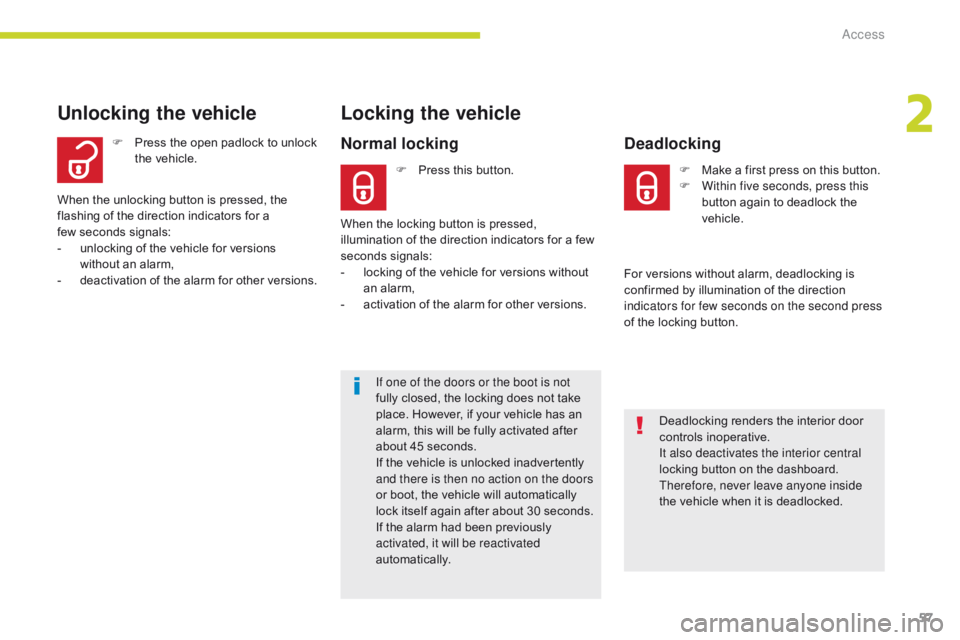
57
B618_en_Chap02_ouvertures_ed01-2016
If one of the doors or the boot is not
fully closed, the locking does not take
place. However, if your vehicle has an
alarm, this will be fully activated after
about 45 seconds.
If the vehicle is unlocked inadvertently
and there is then no action on the doors
or boot, the vehicle will automatically
lock itself again after about 30 seconds.
If the alarm had been previously
activated, it will be reactivated
automatically.
F
P
ress the open padlock to unlock
the vehicle.
Unlocking the vehicle
When the unlocking button is pressed, the
flashing of the direction indicators for a
few
seconds signals:
-
u
nlocking of the vehicle for versions
without an alarm,
-
d
eactivation of the alarm for other versions.
Normal locking Deadlocking
F Press this button. F M ake a first press on this button.
F W ithin five seconds, press this
button again to deadlock the
vehicle.
When the locking button is pressed,
illumination of the direction indicators for a few
seconds signals:
-
l
ocking of the vehicle for versions without
an alarm,
-
a
ctivation of the alarm for other versions. For versions without alarm, deadlocking is
confirmed by illumination of the direction
indicators for few seconds on the second press
of the locking button.
Locking the vehicle
Deadlocking renders the interior door
controls inoperative.
It also deactivates the interior central
locking button on the dashboard.
Therefore, never leave anyone inside
the vehicle when it is deadlocked.
2
Access
Page 64 of 450
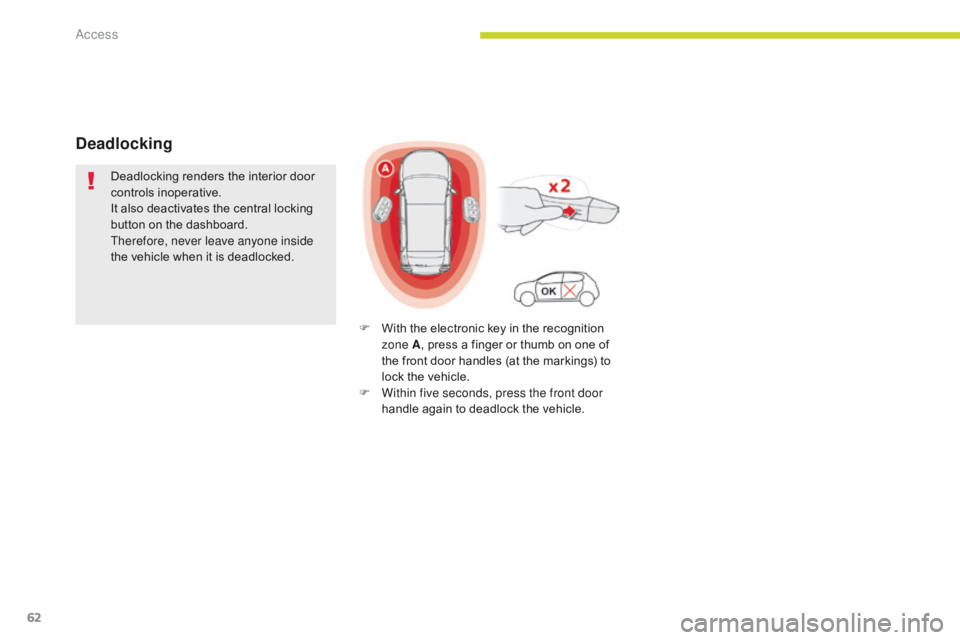
62
B618_en_Chap02_ouvertures_ed01-2016
Deadlocking renders the interior door
controls inoperative.
It also deactivates the central locking
button on the dashboard.
Therefore, never leave anyone inside
the vehicle when it is deadlocked.
Deadlocking
F With the electronic key in the recognition zone A , press a finger or thumb on one of
the front door handles (at the markings) to
lock the vehicle.
F
W
ithin five seconds, press the front door
handle again to deadlock the vehicle.
Access
Page 74 of 450

72
B618_en_Chap02_ouvertures_ed01-2016
* Depending on the country of sale.
Alarm*
System which protects and provides a deterrent
against theft and break-ins. It provides the
following type of monitoring:
- exterior perimeter
The system checks for opening of the vehicle.
The alarm is triggered if anyone tries to open a
door, the boot, the bonnet, etc.
Self-protection function
The system checks for the putting out of
service of its components.
The alarm is triggered if the battery, the central
control or the siren wiring are put out of service
or damaged.For all work on the alarm system,
contact a CITROËN dealer or a
qualified workshop. Following an instruction to lock
the vehicle, the exterior perimeter
monitoring is activated after a delay of
5 seconds.
If an opening (door, boot, etc.) is not
fully closed, the vehicle is not locked but
the exterior perimeter monitoring will be
activated after a delay of 45 seconds.
Locking the vehicle with alarm system
Activation
F Switch off the ignition and get out of the
vehicle.
F
L
ock the vehicle with the remote control
or with the "Keyless Entry and Starting"
system.
The monitoring system is active: the indicator
lamp in the locking button on the dashboard
flashes once per second and the direction
indicators come on for about 2 seconds.
Deactivation
F Unlock the vehicle with the "Keyless Entry and Starting" system.
The monitoring system is deactivated: the
indicator lamp in the locking button goes off
and the direction indicators flash for about
2
seconds.
If the vehicle automatically locks itself
again (as happens if a door or boot
is not opened within 30 seconds of
unlocking), the monitoring system is
also reactivated automatically.
Access
Page 86 of 450

84
B618_en_Chap03_Ergonomie-et-confort_ed01-2016
In order for these systems to be fully effective, follow the operation and maintenance
guidelines below:
F
T
o obtain an even air distribution, take care not to obstruct the exterior air intake grilles
located at the base of the windscreen, the nozzles, the vents and the air outlets, as well
as the air extractor located in the boot.
F
D
o not cover the sunshine sensor, located on the dashboard; this is used for regulation
of the air conditioning system.
F
O
perate the air conditioning system for at least 5 to 10 minutes, once or twice a month
to keep it in per fect working order.
F
E
nsure that the passenger compartment filter is in good condition and have the filter
elements replaced regularly.
W
e recommend the use of a combined passenger compartment filter. Thanks to its
special active additive, it contributes to the purification of the air breathed by the
occupants and the cleanliness of the passenger compartment (reduction of allergic
symptoms, bad odours and greasy deposits).
F
T
o ensure correct operation of the air conditioning system, you are also advised to have
it checked regularly as recommended in the maintenance and warranty guide.
F
I
f the system does not produce cold air, switch it off and contact a CITROËN dealer or a
qualified workshop.
Recommendations for ventilation and air conditioning
If after an extended stop in sunshine,
the interior temperature is very high, first
ventilate the passenger compartment for
a few moments.
Put the air flow control at a setting high
enough to quickly change the air in the
passenger compartment.
The condensation created by the air
conditioning results in a discharge
of water under the vehicle which is
per fectly normal.
When towing the maximum load on a steep gradient in high temperatures, switching off the
air conditioning increases the available engine power and so improves the towing ability.
Stop & Start
The heating and air conditioning
systems only work when the engine is
running.
To maintain a comfortable temperature
in the passenger compartment, you can
temporarily deactivate the Stop & Start
system.
For more information on Stop & Star t ,
refer to the corresponding section.
Ease of use and comfort
Page 132 of 450
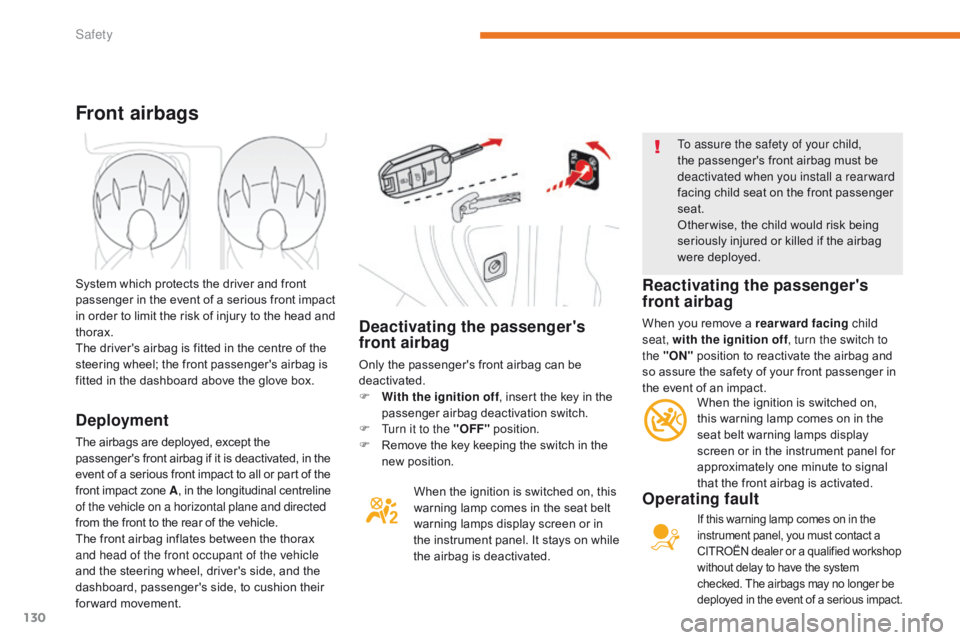
130
B618_en_Chap05_securite_ed01-2016
Deactivating the passenger's
front airbag
Only the passenger's front airbag can be
deactivated.
F
W
ith the ignition off , insert the key in the
passenger airbag deactivation switch.
F
T
urn it to the "OFF" position.
F
R
emove the key keeping the switch in the
new position.
When the ignition is switched on, this
warning lamp comes in the seat belt
warning lamps display screen or in
the instrument panel. It stays on while
the airbag is deactivated. To assure the safety of your child,
the passenger's front airbag must be
deactivated when you install a rear ward
facing child seat on the front passenger
seat.
Other wise, the child would risk being
seriously injured or killed if the airbag
were deployed.
Reactivating the passenger's
front airbag
When you remove a rearward facing
child
seat, with the ignition off , turn the switch to
the "ON" position to reactivate the airbag and
so assure the safety of your front passenger in
the event of an impact.
Front airbags
Deployment
The airbags are deployed, except the
passenger's front airbag if it is deactivated, in the
event of a serious front impact to all or part of the
front impact zone A , in the longitudinal centreline
of the vehicle on a horizontal plane and directed
from the front to the rear of the vehicle.
The front airbag inflates between the thorax
and head of the front occupant of the vehicle
and the steering wheel, driver's side, and the
dashboard, passenger's side, to cushion their
for ward movement. System which protects the driver and front
passenger in the event of a serious front impact
in order to limit the risk of injury to the head and
thorax.
The driver's airbag is fitted in the centre of the
steering wheel; the front passenger's airbag is
fitted in the dashboard above the glove box.
When the ignition is switched on,
this warning lamp comes on in the
seat belt warning lamps display
screen or in the instrument panel for
approximately one minute to signal
that the front airbag is activated.
Operating fault
If this warning lamp comes on in the
instrument panel, you must contact a
CITROËN dealer or a qualified workshop
without delay to have the system
checked. The airbags may no longer be
deployed in the event of a serious impact.
Safety
Page 135 of 450
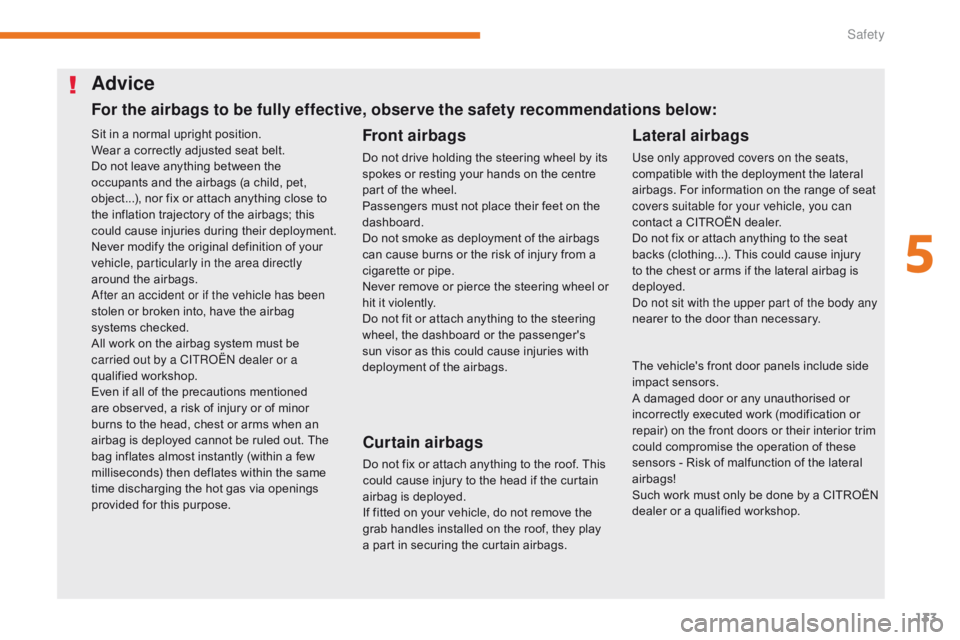
133
B618_en_Chap05_securite_ed01-2016
Sit in a normal upright position.
Wear a correctly adjusted seat belt.
Do not leave anything between the
occupants and the airbags (a child, pet,
object...), nor fix or attach anything close to
the inflation trajectory of the airbags; this
could cause injuries during their deployment.
Never modify the original definition of your
vehicle, particularly in the area directly
around the airbags.
After an accident or if the vehicle has been
stolen or broken into, have the airbag
systems checked.
All work on the airbag system must be
carried out by a CITROËN dealer or a
qualified workshop.
Even if all of the precautions mentioned
are observed, a risk of injury or of minor
burns to the head, chest or arms when an
airbag is deployed cannot be ruled out. The
bag inflates almost instantly (within a few
milliseconds) then deflates within the same
time discharging the hot gas via openings
provided for this purpose.Front airbags
Do not drive holding the steering wheel by its
spokes or resting your hands on the centre
part of the wheel.
Passengers must not place their feet on the
dashboard.
Do not smoke as deployment of the airbags
can cause burns or the risk of injury from a
cigarette or pipe.
Never remove or pierce the steering wheel or
hit it violently.
Do not fit or attach anything to the steering
wheel, the dashboard or the passenger's
sun visor as this could cause injuries with
deployment of the airbags.
Advice
Lateral airbags
Use only approved covers on the seats,
compatible with the deployment the lateral
airbags. For information on the range of seat
covers suitable for your vehicle, you can
contact a CITROËN dealer.
Do not fix or attach anything to the seat
backs (clothing...). This could cause injury
to the chest or arms if the lateral airbag is
deployed.
Do not sit with the upper part of the body any
nearer to the door than necessary.
Curtain airbags
Do not fix or attach anything to the roof. This
could cause injury to the head if the curtain
airbag is deployed.
If fitted on your vehicle, do not remove the
grab handles installed on the roof, they play
a part in securing the curtain airbags.
For the airbags to be fully effective, observe the safety recommendations below:
The vehicle's front door panels include side
impact sensors.
A damaged door or any unauthorised or
incorrectly executed work (modification or
repair) on the front doors or their interior trim
could compromise the operation of these
sensors - Risk of malfunction of the lateral
airbags!
Such work must only be done by a CITROËN
dealer or a qualified workshop.
5
Safety
Page 171 of 450

169
B618_en_Chap06_conduite_ed01-2016
In the event of a fault with the system, the
indicator lamp in the button flashes for a
few moments, then remains on.
Have it checked by a CITROËN dealer or a
qualified workshop.
Operating fault
In the event of a fault in STOP mode, the
vehicle may stall.
All of the instrument panel warning lamps
come
on.
It is then necessary to switch off the ignition
and start the engine again.
In certain circumstances, such as the need
to maintain the temperature in the passenger
compartment, it may be useful to deactivate the
Stop & Start system.
The system can be deactivated at any time,
once the ignition is switched on.
If the engine is in STOP mode, it then restarts.
The Stop & Start system is reactivated
automatically every time the ignition is
switched
on.
Deactivation / Reactivation
The Stop & Start system requires
a 12 V battery of specific technology
and specification.
All work on this type of battery must be
carried out only by a CITROËN dealer
or a qualified workshop.
For more information on the 12 V
Battery , refer to the corresponding
section.
Before doing anything under the bonnet,
deactivate the Stop & Start system to
avoid the risk of injury related to an
automatic change to START mode. Opening the bonnet
Driving on flooded roads
Before driving through a flooded road,
it is strongly recommended that you
deactivate the Stop & Start system.
For more information on Driving
advice , particularly on flooded roads,
refer to the corresponding section. F
P
ress this switch.
Deactivation is confirmed by the illumination of
the indicator lamp in the control switch and the
display of a message.
Pressing the switch again reactivates the
system.
The indicator lamp in the switch goes off,
accompanied by the display of a message.
With the switch on the dashboard
6
Driving
Page 184 of 450

182
B618_en_Chap06_conduite_ed01-2016
Fatigue detection system
As soon as the speed of the vehicle
drops below 40 mph (65 km/h), the
system goes into standby.
The driving time is counted again once
the speed is above 40 mph (65 km/h).
It is recommended that you take a break as soon as you feel tired or at least every two hours.
The system cannot in any
circumstances replace the need for
vigilance on the part of the driver.
Do not take the wheel if you are tired.
Driving time warning
The system triggers an alert once it detects that
the driver has not taken a break after two hours
of driving at a speed above 40 mph (65 km/h).
This alert takes the form of the display of a
message encouraging you to take a break,
accompanied by an audible signal.
If the driver does not follow this advice, the
alert is repeated hourly until the vehicle is
stopped. The system resets itself if one of the following
conditions is met:
-
e
ngine running, the vehicle has been
stationary for more than 15 minutes,
-
t
he ignition has been switched off for a
few
m
inutes,
-
t
he driver's seat belt is unfastened and
their door is open.
Activation / Deactivation
The system is activated or deactivated via the
vehicle configuration menu.
For more information on the menu, refer to the
part covering your screen in the "Dashboard
instruments" section.
The state of the system stays in memory when
the ignition is switched off.
Driving